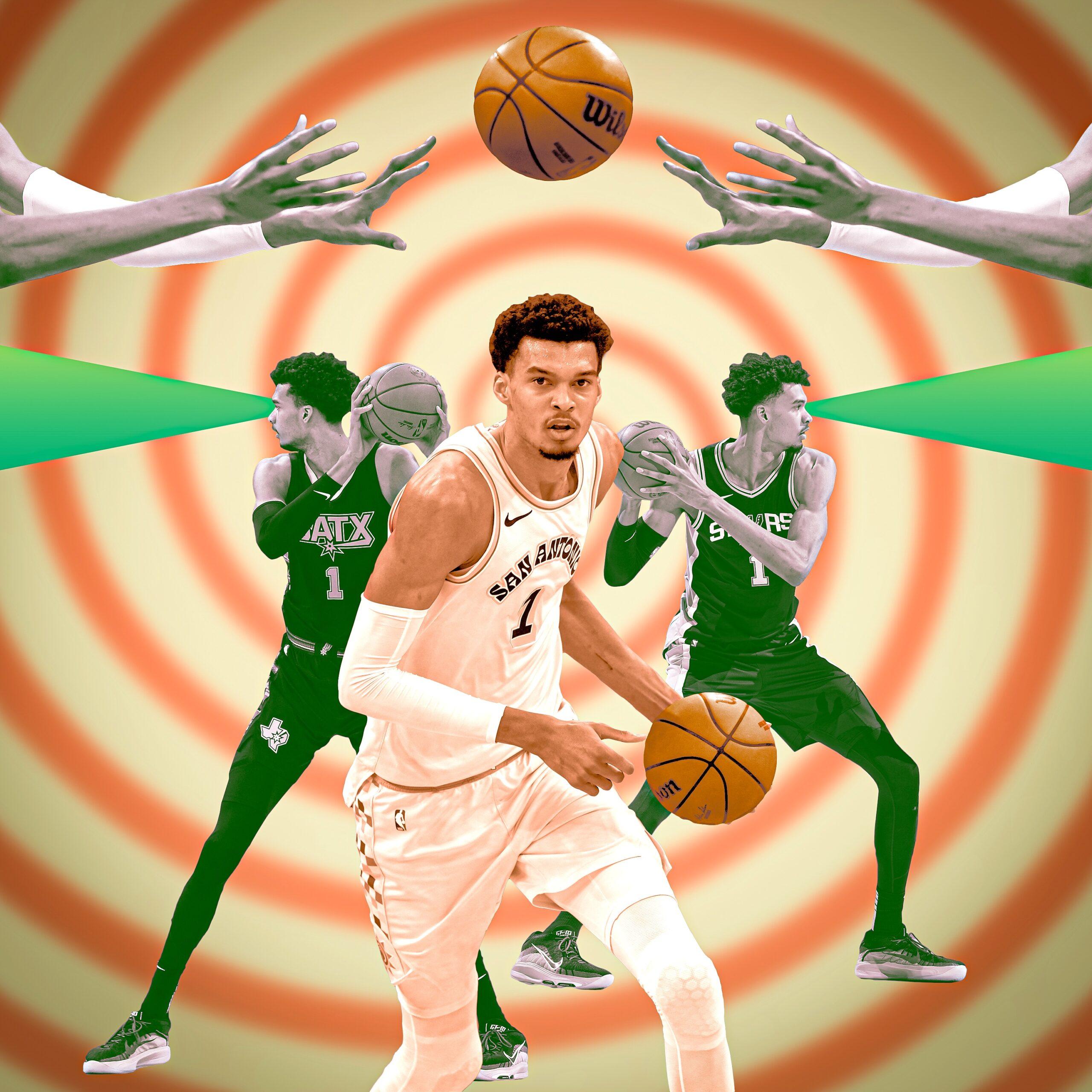
It’s an early evening in late December at Barclays Center, and the San Antonio Spurs are about to play the Brooklyn Nets. Plopped on a folding chair in front of Victor Wembanyama’s locker is Wind and Truth, a new epic fantasy by Brandon Sanderson that spans 1,344 pages. It’s the fifth book in a series whose next volume is expected in 2031, which is the same year Wembanyama will (a) turn 27 and (b) crack the opening chapter of a prime that may be unlike anything basketball has ever seen.
By then, Wemby’s achievements probably won’t fill a door-stopping tome, but the possibility can’t be ruled out. As the NBA’s leader in height and wingspan, Wembanyama is still finding ways to harmonize his surreal physical gifts with an uncanny skill set, fearless intellect, and competitive drive. Even with so much time to reach a ceiling that may not even exist, last month felt like the first sustained stretch in which Wemby’s hype morphed into a tangible impact on winning. In December, he averaged 28.5 points, 10 rebounds, and 4.4 blocks per game, more than doubling his free throw attempts from November. He finished with a 62.6 true shooting percentage, a 32.8 usage rate, and only six players in the entire league made more 3-pointers.
As the NBA’s ascendent main character, Victor is just about mythological. A big man who was the runner-up for Defensive Player of the Year as a rookie should not be able to handle, shoot, and move like a guard. A player who turned 21 last week should not go toe-to-toe with a three-time MVP or break everyone at Madison Square Garden’s brain in his Christmas Day debut. Wembanyama is virtually unprecedented and impossible to game-plan for—a generation-eclipsing bogeyman who’s finally shedding his training wheels.
But as he learns more about himself, basketball, and a league he seems destined to conquer, at this stage the most compelling, functional, and propitious part of Wemby’s game is also the easiest to overlook: his passing. Wembanyama strode into the league with selfless tendencies and a natural appreciation for getting others involved. But the ability to leverage defensive attention and then consistently spin it into a positive outcome for someone else often takes years for a star guard to develop—let alone a center—and ultimately separates great offensive players from ones we won’t ever forget. Right now Wembanyama is showing why he’s on the latter path.
“I think it’s a work in progress, because it’s for sure the next step in my career, you know?” Wembanyama said when I asked him to assess his growth as a playmaker from last season to present day. “I mean, I want to make my teammates better, but also know I need to be more assertive on the court in order to free my teammates, to give them open shots. It’s definitely a path I want to explore fully.”
In NBA history, only three centers (Alvan Adams, Bill Walton, and Brad Daugherty) have assisted more baskets in their first 102 games than Wembanyama. In December, he averaged 7.8 potential assists per game—the most through any month in his career—and showed off all the ways he can decode defensive matchups and strategies that are designed to test his patience and make him think.
Some opponents guard Wemby with a physical wing or guard and keep their own center as a help defender near the rim. When he sets a screen or initiates the action, defenses will switch to take away a pick-and-pop 3, then either stay home to make him attack one-on-one, load up on the strong side, or hard double as soon as he puts the ball on the floor. In the post, they poke and shove and front and do everything within their power to wear him down.
The kitchen-sink coverages are a response to Wemby’s growing threat as a dominant scorer, but his vision is starting to propel him one step ahead. “It takes time when you’re guarded in some of the unique ways as teams have schemed for him,” says Spurs acting head coach Mitch Johnson. “And I think he’s starting to get a little bit of a hold sometimes on some of the patterns that you see over and over and over again. Elite players can take advantage … and we’re starting to see a little bit of that.”
Effective playmaking requires the ability to react on the fly and make one correct split-second decision after another. The greats are able to anticipate what’s going to happen and process a whirl of commotion without getting sped up. It’s an evolutionary step happening right now for Wembanyama.
“[It’s] kind of how Luka sees things. He could be driving, he’ll pick up his dribble, and he still has so much more time in his head. Everything is so slow. It’s what makes guarding Luka so hard,” Spurs center Zach Collins tells me. “You’ll be guarding him and he’ll look like he’s shooting, and all of a sudden he sees something right at the end before he hits the ground. It seems like [Victor] is doing that now, especially with the lobs to Jeremy [Sochan] at the last second. It seems like he’s developing that skill.”
Those plays illuminate the cause-and-effect Wembanyama referenced earlier: the more lethal he is as a scorer, the more havoc his passes will wreak. The best example so far comes from crunch time of that aforementioned matchup with Nikola Jokic in Denver, when he rose up from 30 feet and had three (three!) Nuggets try to block his shot. It left two Spurs wide open in the paint.
A plurality of Wembanyama’s assists are to Sochan. His teammates were floored by one in particular during the fourth quarter of a recent win against the Hawks. “It felt like it hit the ceiling, he lobbed it so high,” Collins said. “And to me it looked like a terrible pass … I didn’t know where it was going until Jeremy caught it and dunked it.”
“That was pretty …” Sochan searches for the right word before laughing. “We’re both European players, so we’re not selfish and we really care about and respect team basketball, and I think we know with each other, we’re gonna cut, we’re gonna screen for each other, and just reading, reacting.”
Wembanyama is averaging the same number of assists as last season (when he showed real promise with some highlight-reel dimes), but there are contextual factors—like the various benefits of having Chris Paul as his point guard—that make it hard for basic numbers to track his improvement.
He’s inventive in the way someone with access to new technology can accomplish things of which preceding generations could only dream. His arms are long enough to wrap a pass around defenders who’d otherwise deflect it, and his hands are large enough to cradle the ball like a grape, whipping no-look touch passes before the defense can blink.
Regardless of who’s guarding him, Wemby’s eyes air-traffic-control the game. “He’s the tallest player out there,” Spurs point guard Tre Jones says. “So he’s able to make his reads, make his move, and can see the entire floor. When he takes his time he can make anything happen.”
That means locating open teammates before he flings a line drive from one sideline to the other in the face of a swarming double-team …
Or firing darts to cutters as they scoot behind help defenders who can’t take their eyes off the ball:
“He’s able to make passes that you really only see certain guys make in the entire NBA. He’s able to make pocket passes as a 7-5 player. He’s able to make skips across the court. He goes up for jump shots and sees guys in his peripheral,” Jones says. “I think the best way to describe it is it’s just a gift that was given to him from God.”
In late November, Wembanyama carved up the Warriors with five assists in the fourth quarter of a comeback win. He made shrewd decisions off the dribble, in one case driving left past Brandin Podziemski (a guard!) as help defenders scrambled to cut him off—something very few big men can do—before tossing a perfect lob to Julian Champagnie:
Wembanyama does a good job mixing simple, effective reads that emerge from exhaustive film study and counsel from veteran teammates (like Paul) with extemporaneous blips of paranormal activity. But sometimes the outsized confidence endemic among budding NBA superstars crashes headfirst into the typical growing pains suffered by a 21-year-old with enormous two-way responsibility. The results are unforced errors the Spurs would surely like to avoid. His turnover rate is currently in the 33rd percentile among all big men, and his 1.74 bad-pass turnovers per game are second most among all centers. Some are wild. Others would have been the right idea if his teammates had thought he would be audacious enough to make them.
At this stage, though, Wembanyama’s willingness to be bold is what matters. Having a franchise center who (a) can read the court and (b) wants to make life easier for his teammates reaps myriad long-term benefits for a Spurs organization that still isn’t positive about the best way to build around Wembanyama. His game is protean and carries unknowable benefits. He already leads the NBA in blocks. He may eventually lead the league in scoring. The passing, though, is pivotal. It expands the list of players who make sense around him and reduces the types who aren’t compatible.
Spurs guard Malaki Branham mentions Jokic when I ask for his thoughts on Wemby’s potential impact as a setup man. “It’s gonna be crazy the way he’s gonna be passing the ball,” he says. “He’s gonna get triple-doubles on a nightly basis, man.”
As the Spurs make strides to attract top-tier talent, Wembanyama’s playmaking raises a fundamental question that should terrify every other NBA team even more than they already are: How could anyone watch this dude and not want to be his teammate? “It makes the game so much easier, knowing that a guy like that, who can potentially go score a bucket every play, is making the right play a majority of the time,” Spurs rookie Stephon Castle says. “It makes the game more fun, but it [also] gives our team the best chance at winning.”





